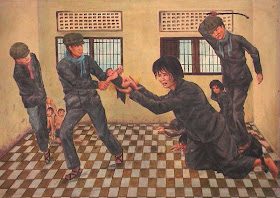I’ve chosen five works by Sargent: two portraits and three paintings from Italy that show just what can be done with a limited pallette.
As we have seen in an earlier post rather than the academic method taught in most of the ateliers in Paris, Sargent was introduced to a more direct painting method by Carlos Duran. As you can see in these paintings, he used bold brushwork and simplified and abstracted the descriptions of form. The paintings are full of bravado passages of direct strokes of paint with glowing touches of light and shadow producing painterly effects with lots of lost and found edges. To pull this off he had to be able to draw with the brush, for every brushstroke is put down and left. In many of his studies and some of his formal portraits, Sargent employs a very limited palette in these paintings I’ve selected..
Yellow Ochre (or possibly mars yellow)
Burnt Sienna ( iron oxide red or again a mars red, )
Ivory Black
White (Flake White)
The first painting "A Spanish Woman" was painted in 1879 and that of "Antonio Mancini" in1898. Both portraits are quick studies. The one of Mancini (a friend of Sargent} was painted in little more than an hour using heavy impasto. Both paintings show the importance of understanding that everything is either in the light or in the shadow. Sargent was able to use strong contrasts of value because of the lack of contrasting colour. You have to decide on one or the other.
 |
| A Spanish Woman |
 |
| Antonio Mancini |
Sargent was 26 years old when he visited Venice in 1882. In this painting we can see how a limited pallette harmonises a painting while the dramatic use of black has been used to build the story and the composition. Notice that none of the shapes within the buildings are repeated and the individual elements including the negative spaces are abstracted. This is probably a very accurate depiction of local Viennese life in 1882, the year after Billy the Kid was shot dead by Pat Garret!
 |
| Venice 1882 |
"Interior of Dodge's Palace" 1898
Again the same limited pallette with plenty of black. What can you say? Look how Sargent has depicted, Tintoretto's Paradise along the far wall and the oval ceiling painting by Paolo Veronese "Triumph of Venice"
 |
| Interior of Dodge's Palace |
"Corner of the Church of San Stae" 1913
Sargent could do so much with so little, this painting has a phenomenal colour unity with no discordant notes because of the limited pallette. The church has been given a restrained dignity and elegance despite the dilapidation of it’s facade.
Again the lights are so well handled with highlights, core shadows and reflected light giving a strong sense of the third dimension.
You will notice that the core shadows appear on the two columns where the sunlight hits them but disappear again in the shadows, this is a very important thing to understand.
And once again we see the importance of things are either in the light or in the shadow. Sargent never jumped the light. Also note the abstraction of shapes and the avoidance of any repetitive painting of the individual elements.
 |
| Corner of the Church of San Stae |
 |
| Detail of the above Church. |
















